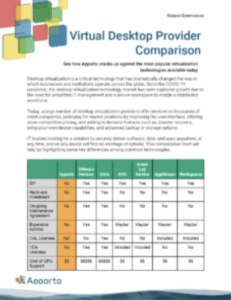In today’s digital age, virtual desktop infrastructure (VDI) has become a popular solution for businesses seeking enhanced flexibility, centralized management, and improved security. When considering VDI options, two main approaches emerge: multi-user virtual desktops and dedicated virtual desktops. Each has its unique strengths and considerations. In this blog post, we will compare these two approaches to help you make an informed decision about which solution is best suited for your business needs.
Multi-User Virtual Desktops:
Multi-user virtual desktops, also known as session hosts or shared desktops, are designed to allow multiple users to share a single server operating system instance. These virtual desktops enable multiple users to simultaneously access applications and data from a centralized server infrastructure. Here are some key advantages and considerations of multi-user virtual desktops:
Advantages:
- Cost-effective: Multi-user virtual desktops can significantly reduce hardware and licensing costs compared to dedicated virtual desktops, as resources are shared among multiple users.
- Efficient resource utilization: By leveraging shared resources, multi-user virtual desktops optimize server infrastructure and reduce the overall hardware footprint.
- Easy management: With a single instance to manage, updates, patches, and application installations are streamlined, reducing administrative overhead.
- Scalability: Multi-user virtual desktops can easily accommodate a growing number of users by adding additional session hosts or increasing server resources.
Considerations:
- Limited customization: Shared desktop environments restrict individual user customization options due to the shared nature of resources.
- Performance impact: Heavy resource utilization by one user can potentially impact the performance of other users sharing the same server.
- Application compatibility: Some applications may not be compatible with multi-user environments, requiring additional testing and configuration.
Virtual Desktop Provider Comparison
Dedicated Virtual Desktops:
Dedicated virtual desktops, also referred to as single VMs or one-to-one desktops, provide each user with a dedicated virtual machine. This approach offers individual isolation and customization options. Let’s explore the advantages and considerations associated with dedicated virtual desktops:
Advantages:
- Personalization: Each user has complete control over their desktop environment, allowing customization and installation of applications tailored to their specific needs.
- Performance consistency: Dedicated virtual desktops provide consistent performance as resources are not shared among multiple users.
- Application compatibility: Applications that require specific configurations or isolation can be easily accommodated on dedicated virtual desktops.
Considerations:
- Higher costs: Dedicated virtual desktops require additional hardware resources, resulting in increased infrastructure and licensing costs.
- Resource inefficiency: As each user has their own virtual machine, resource utilization may be less efficient compared to multi-user virtual desktops.
- Management complexity: Managing individual virtual machines can be more complex and time-consuming, especially as the number of users grows.
The Apporto Difference:
Apporto is a fully managed, turnkey desktop-as-a-service (DaaS) platform with a 100% ‘Would Recommend’ rating by Gartner verified peer reviews. Flexibility is at the core of the Apporto service and both multi-user and dedicated virtual desktops are offered. Further, persistent user profiles can be enabled for all users regardless of desktop option, and for extreme cases of user control, dedicated persistent desktops can be deployed.
Billing is also flexible with both a fixed cost-per-seat model or a consumption-based model with auto-scaling enabled. The latter does a great job for a fluctuating workforce made up of contract or seasonal employees.
Conclusion:
When deciding between multi-user virtual desktops and dedicated virtual desktops, understanding your business requirements is crucial. If cost-effectiveness, efficient resource utilization, and streamlined management are paramount, multi-user virtual desktops may be the preferred choice. On the other hand, if personalization, application compatibility, and individual performance consistency are critical factors, dedicated virtual desktops offer greater flexibility.
In many cases, businesses find a hybrid approach to be the ideal solution, leveraging both multi-user and dedicated virtual desktops to strike the right balance between cost, customization, and performance. Assess your organization’s specific needs and consult with IT professionals to determine the most suitable VDI solution for your business, ensuring optimal productivity, user experience, and long-term success.
Happy Computing!



